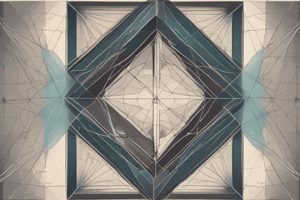Podcast
Questions and Answers
A rectangle, by definition, can never have all four sides of equal length.
A rectangle, by definition, can never have all four sides of equal length.
False (B)
Vertical lines, by definition, never intersect.
Vertical lines, by definition, never intersect.
False (B)
An obtuse angle measures greater than $90$ degrees but less than $180$ degrees.
An obtuse angle measures greater than $90$ degrees but less than $180$ degrees.
True (A)
The perimeter of a rectangle with length $l$ and width $w$ is calculated as $l \times w$.
The perimeter of a rectangle with length $l$ and width $w$ is calculated as $l \times w$.
Spatial reasoning only involves visualizing static shapes and not mentally manipulating them.
Spatial reasoning only involves visualizing static shapes and not mentally manipulating them.
Categorizing 2D shapes involves understanding their attributes such as sides, vertices, and angles.
Categorizing 2D shapes involves understanding their attributes such as sides, vertices, and angles.
A sphere is a three-dimensional shape characterized by faces, edges, and vertices.
A sphere is a three-dimensional shape characterized by faces, edges, and vertices.
Calculating the area of a square with sides of length 5 involves adding all the sides together.
Calculating the area of a square with sides of length 5 involves adding all the sides together.
Flashcards
Basic Shapes
Basic Shapes
Fundamental geometric shapes like squares, rectangles, triangles, and circles.
Properties of Squares
Properties of Squares
Squares have four equal sides and four right angles.
Types of Angles
Types of Angles
Angles are classified as acute, obtuse, right, straight, and reflex based on their measurement.
Measuring Angles
Measuring Angles
Signup and view all the flashcards
Perimeter of Shapes
Perimeter of Shapes
Signup and view all the flashcards
Area of Squares and Rectangles
Area of Squares and Rectangles
Signup and view all the flashcards
Spatial Reasoning
Spatial Reasoning
Signup and view all the flashcards
3D Shapes
3D Shapes
Signup and view all the flashcards
Study Notes
Basic Shapes
- Fourth graders begin by learning about fundamental shapes such as squares, rectangles, triangles, and circles.
- They identify these shapes by their defining characteristics: e.g., squares have four equal sides and four right angles; rectangles have four sides with opposite sides equal and four right angles; triangles have three sides and three angles; circles have all points equidistant from a center point.
- Students analyze these shapes by describing their properties, such as the number of sides, angles, and the relationship of the sides and angles.
Lines and Angles
- Understanding lines and angles is a crucial aspect of geometry.
- Students learn about different types of lines: horizontal, vertical, parallel, perpendicular, and intersecting lines. They learn how the lines relate to each other in terms of their positions, slopes, and points of intersection.
- Additionally, students learn about different types of angles (acute, obtuse, right, straight, and reflex angles) and how to measure and classify them using a protractor. Key skills include accurately measuring angles and identifying the angle type based on its measurement.
Measuring Angles and Sides
- Fourth grade geometry introduces the need to measure angles and sides accurately.
- Students begin to use tools like protractors and rulers to find measurements of lengths and angles within shapes.
- Important understanding is created by correlating the measurements to the properties of the different shapes discussed.
Perimeter and Area of Squares and Rectangles
- The calculation of perimeter and area is introduced for squares and rectangles.
- Perimeter is the total distance around the outside of a shape, calculated by adding all side lengths for squares and rectangles.
- Area is the amount of space inside a shape. For squares and rectangles, students learn to calculate area by multiplying length and width.
Developing Spatial Reasoning
- Geometry in fourth grade emphasizes the development of spatial reasoning skills.
- Students learn to visualize shapes in different orientations, mentally manipulate shapes, imagine combining or breaking down shapes, and identify relationships between shapes.
- Hands-on activities with manipulatives or drawings are used to help students master these spatial reasoning skills.
2D Shapes
- Students categorize two-dimensional shapes, identifying shared characteristics and recognizing differences. Key is defining and classifying shapes.
- Understanding attributes (sides, vertices, angles) is crucial for categorizing.
3D Shapes
- Three-dimensional shapes (cubes, rectangular prisms, spheres, cones, and cylinders) are introduced.
- Students identify and describe these shapes by their faces, edges, and vertices.
- Understanding different 3D shapes progresses as students classify them using common attributes. Hands-on, visual learning, involving constructing shapes with materials like blocks or paper, is emphasized.
Studying That Suits You
Use AI to generate personalized quizzes and flashcards to suit your learning preferences.




